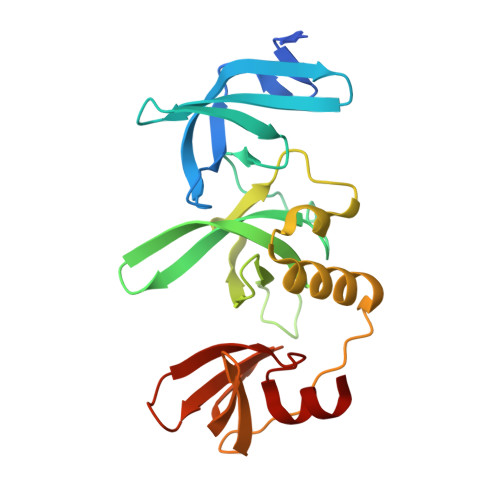Potent and selective SETDB1 covalent negative allosteric modulator reduces methyltransferase activity in cells.
Uguen, M., Shell, D.J., Silva, M., Deng, Y., Li, F., Szewczyk, M.M., Yang, K., Zhao, Y., Stashko, M.A., Norris-Drouin, J.L., Waybright, J.M., Beldar, S., Rectenwald, J.M., Mordant, A.L., Webb, T.S., Herring, L.E., Arrowsmith, C.H., Ackloo, S., Gygi, S.P., McGinty, R.K., Barsyte-Lovejoy, D., Liu, P., Halabelian, L., James, L.I., Pearce, K.H., Frye, S.V.(2025) Nat Commun 16: 1905-1905
- PubMed: 39994194
- DOI: https://doi.org/10.1038/s41467-025-57005-3
- Primary Citation of Related Structures:
9CUW, 9CUX - PubMed Abstract:
A promising drug target, SETDB1, is a dual methyl-lysine (Kme) reader and methyltransferase implicated in cancer and neurodegenerative disease progression. To help understand the role of the triple Tudor domain (3TD) of SETDB1, its Kme reader, we first identify a low micromolar potency small molecule ligand, UNC6535, which occupies simultaneously both the TD2 and TD3 reader binding sites. Further optimization leads to the discovery of UNC10013, a covalent 3TD ligand targeting Cys385 of SETDB1. UNC10013 is potent with a k inact /K I of 1.0 × 10 6 M -1 s -1 and demonstrates proteome-wide selectivity. In cells, negative allosteric modulation of SETDB1-mediated Akt methylation occurs after treatment with UNC10013. Therefore, UNC10013 is a potent, selective, and cell-active covalent ligand for the 3TD of SETDB1, demonstrating negative allosteric modulator properties and making it a promising tool to study the biological role of SETDB1 in disease progression.
- UNC Eshelman School of Pharmacy, Center for Integrative Chemical Biology and Drug Discovery, Chemical Biology and Medicinal Chemistry, University of North Carolina at Chapel Hill, Chapel Hill, NC, USA.
Organizational Affiliation:




















